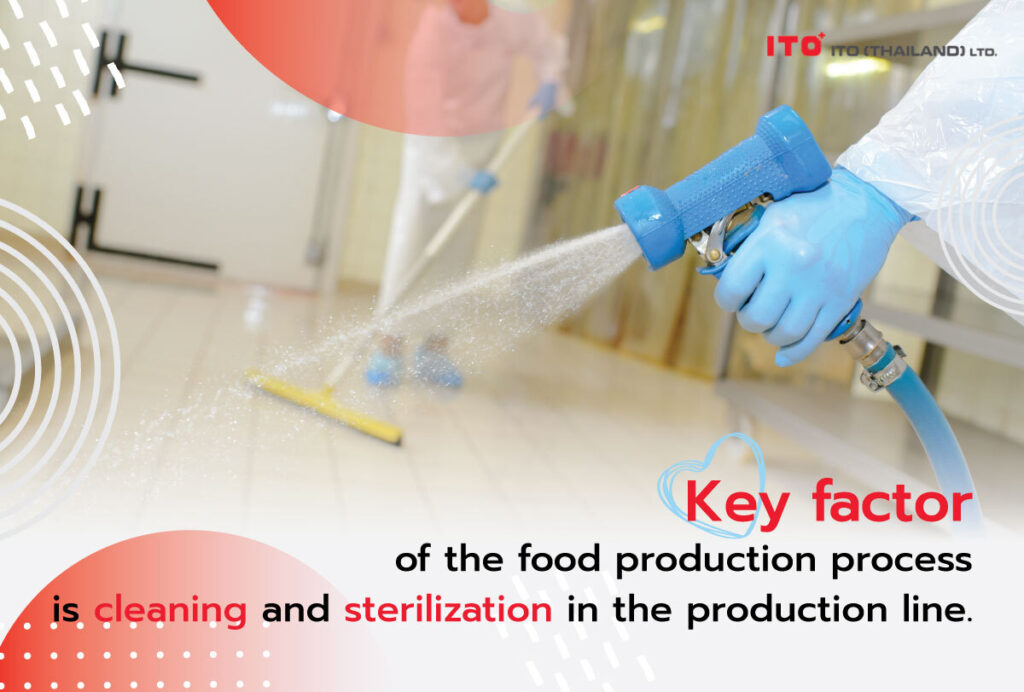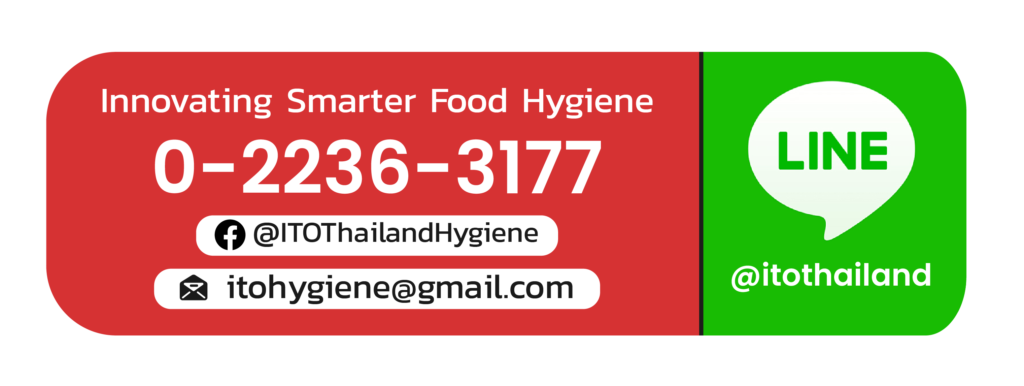ITO Thailand Hygiene Blog
Cleaning and disinfection in food production lines
Apart from microorganisms, cleaning is also important to elimination of undesirable hazards that may be found in a food plant such as allergens, carcinogens from high temperature grilling, heat-damaged protein-based stains, chemical residues, etc. All of these problems are the main causes to be strictly focused in order to keep food production clean and safe in addition to keep the image of the organization due to affecting the consumer trusts and standards of both local and international legislations. Therefore, as a part of those in the food production process, it is required to understand the cleaning and disinfection procedures for proper implementation.
Types of surfaces to be cleaned can be divided into 2 types according to the risks or vicinity to food:
♦ Zones of direct food contact surfaces such as cutting tools, chopping boards, conveyor belts, workers’ hands, surfaces of food packaging tables, etc. These surfaces require rigorous and careful selection in order to meet good standards; for example, the material must be non-toxic or reactive to food, corrosion resistant, smooth surfaces against deposits of microorganisms or humidity and strong enough to withstand scratches caused by work operations. These food contact surfaces must be cleaned and disinfected regularly.
♦ Zones of no direct food contact surfaces but in the vicinity such as under the tables, on-off switches, areas in the product rooms, pushcarts’ wheels, boots, sewers, rest areas, locker rooms, etc. These zones are not required the control as strict as those of the previous zones but cleaning and disinfection must be regularly done to prevent food contamination [1].
Cleaning and disinfection procedures are divided into cleaning and disinfection [2]
Cleaning is aimed at removing visible stains of dirtiness, oiliness, chemical residues. allergens or any undesirable substances from the surfaces in order to make the disinfection process efficient. This cleaning may be cleaned by having a human being remove some or all parts of the equipment to clean: Mechanical cleaning, Clean-out-of-Place (COP) or Clean-in-Place (CIP) depending on the types and limitation of the surfaces. The worker must pay particular attention to every nook and cranny of the machine and equipment due to the cleaning may be neglected in hardly accessible areas.
Physical cleaning can be done by wiping out with a brush, cloth or other materials to remove dirt embedded on the surfaces such as burnt food stains, biofilm stains or microbial mucus, lipid residues, mineral slags, dust particles, etc. Chemical cleaning is using the solubility of substance’s chemical properties to dissolve the stains on the surfaces which is a very popular method. The solvent used depends on the properties of the stains as follows [2]:
Lipid residues cannot be removed with plain water due to lipid is not soluble in water. Therefore, the water which is hotter than the lipid melting point may be used to wash in conjunction with the pressure or detergents with alkaline properties or an emulsifier to act as a stabilizer for emulsion; or several methods may be used in case the stain is very sticky.
Protein stains range from the easy-to-clean protein to the hardest-to-clean protein of all food stains. Since the protein is deteriorated when heated, its property will turn it into stain embed firmly on the surface. To dissolve the protein stains, it may be necessary to use a highly alkaline-based detergent or wetting agent to help solubility.
Carbohydrate stains In case of small molecules; for instance, sugar which is soluble in water, hot water or mild detergent may be used to dissolve. In case of large molecules or complex structures, alkaline-based detergent may be used to clean.
Salt stains, mineral slags often found in the form of slags. Some types of salt are soluble in water but some types of salt, such as calcium and magnesium, require heat and acid to help dissolving. Using alkali will cause the salt to react with the alkali forming bicarbonate compounds or insoluble limestone. In addition, some types of salt are corrosive to the surface or cause metal surface to rust requiring a lot of attention to cleaning because if the surface is corroded, it will be rugged and embedded with stains of microorganisms causing it more difficult to clean.
Stains of microorganisms, such as bacteria, yeast, fungi, can form a biofilm that makes microorganisms firmly stick to the surface and difficult to remove. In addition to cleaning, disinfectants must also be used to eliminate the cause of the biofilm.
In addition to chemicals, biological cleaning methods are currently developed; for example, use of microorganisms or enzymes (such as proteases, cellulases, polysaccharide depolymerases, alginate lyases, dispersin B, and DNAse) to help removing biofilms instead of chemical use. However, the development of these bio-cleaning substances is still in the research phase [3].
Disinfection must be done following the cleaning in order to reduce the microbial counts on the surface to an acceptable level by mainly targeting the pathogens and microorganisms that affect the product quality to be at safe level. Disinfection may be done by physical methods (e.g. temperature of hot water, steam or hot air), biological methods (e.g. enzymes or microorganisms), radiation (e.g. gamma rays, pulsed light, UV light); however, the most popular method is use of chemicals such as chlorine, iodine, ozone, Quaternary Ammonium Compounds (QACs), peroxide, fatty acids, Peroxyacetic Acid (PAA), etc. The implementation of this method must be under food safety statutory regulations.
Cleaning and disinfection are the vital fundamentals of food safety. Proper cleaning and disinfection are the major parts in maintaining food safety standards for consumers, market competition and statutory regulation compliance.
ITO Thailand would like to be a part of food safety society promotion in Thailand.
Reference:
1.Sullins M., Dice C. (2021). Demystifying cleaning and sanitizing of food contact surfaces on the farm. Colorado Produce Safety Collaborative.
2.Schmidt, R. H. (1997). Basic elements of equipment cleaning and sanitizing in food processing and handling operations. University of Florida Cooperative Extension Service, Institute of Food and Agriculture Sciences, EDIS.
3.Delhalle, L., Taminiau, B., Fastrez, S., Fall, A., Ballesteros, M., Burteau, S., & Daube, G. (2020). Evaluation of enzymatic cleaning on food processing installations and food products bacterial microflora. Frontiers in Microbiology, 11, 1827.
Related Post
-
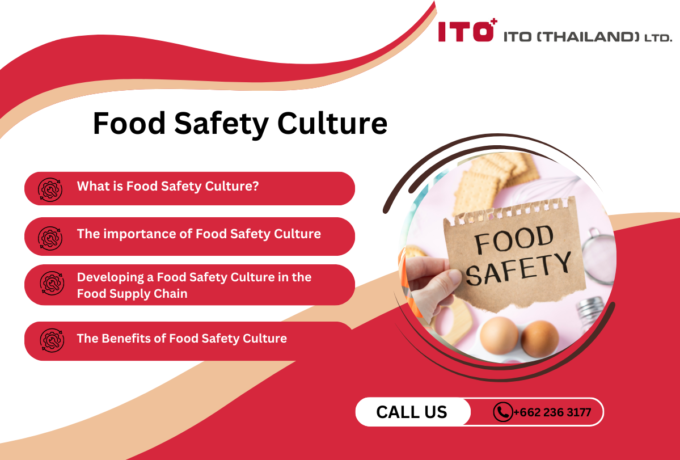
Food Safety Culture
Food safety culture plays a crucial role in safeguarding the company's reputation, ensuring the well-being of its employees, and providing a safe experience for its customers.
-
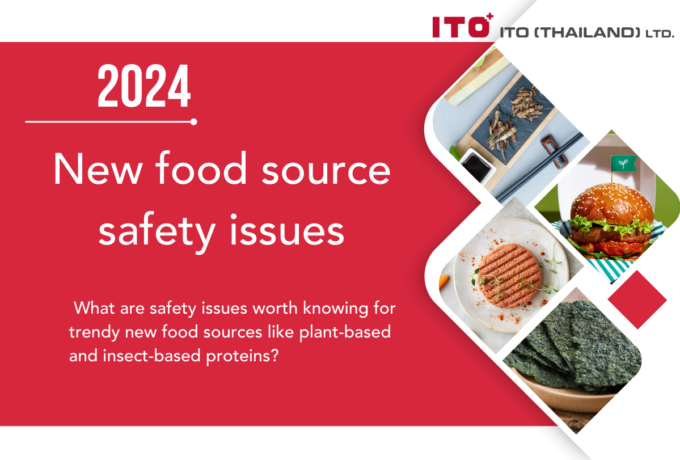
New food source safety issues
What are safety issues worth knowing for trendy new food sources like plant-based and insect-based proteins?
-

British Retail Consortium (BRC) Standard
Food safety management systems play a vital role in ensuring the production and distribution of safe and high-quality food products to consumers. With the global food supply chain becoming increasingly complex, food businesses must implement effective systems prioritising safety, quality, and compliance with industry standards. A food safety management system encompasses a set of procedures, processes, and controls designed to identify, prevent, and manage potential hazards at every stage of the food production and supply process. This proactive approach not only safeguards consumers' health but also protects the reputation and credibility of food companies in an ever more competitive market.
-
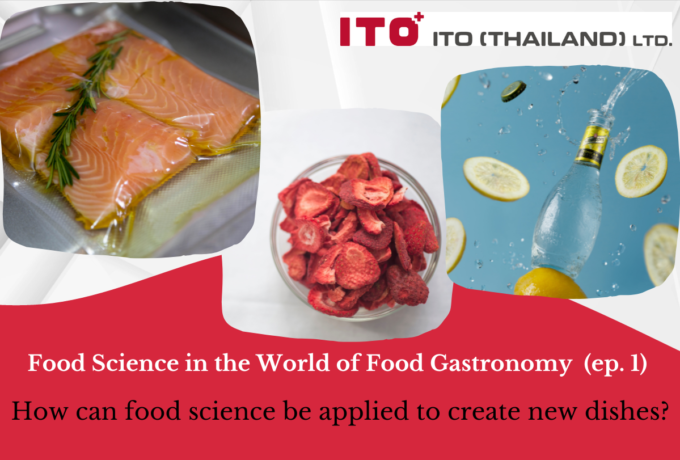
Food Science in the World of Food Gastronomy (Part 1)
How can food science be applied to create new dishes?
-
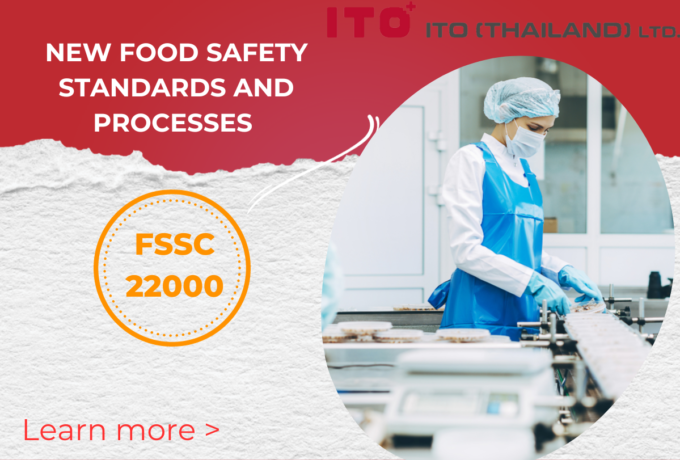
FSSC 22000
Food manufacturers must ensure food safety standards and processes. FSSC 22000 is an official certification program for Food Safety Management Systems (FSMS) recognised by the Global Food Safety Initiative (GFSI). This certification scheme offers a set of guidelines and procedures to ensure uniformity, openness, and safety across your entire supply chain. It applies to all companies operating within the food and beverage industry, ranging from farmers to retailers. By fulfilling the necessary criteria and obtaining FSSC 22000 certification, it is demonstrated that the required standards for food quality and implementing effective processes to manage and mitigate risks associated with food fraud, foodborne illnesses, expensive recalls, and other external threats are met.
-

Food Safety Aspects of Artificial Sweeteners
Artificial sweeteners, also known as sugar substitutes, non-nutritive sweeteners, or high-intensity sweeteners, are artificially produced compounds utilised in place of sucrose (table sugar) to add sweetness to food and drinks. Due to their significantly higher sweetness than regular sugar, only a fraction of artificial sweeteners (200 to 20,000 times less) is required to achieve an equivalent level of sweetness. Since the caloric contribution of these sweeteners, when used in such small quantities, is insignificant, they are often referred to as non-nutritive (4).








